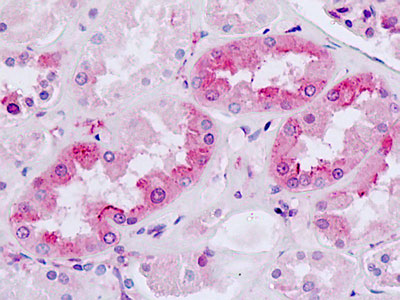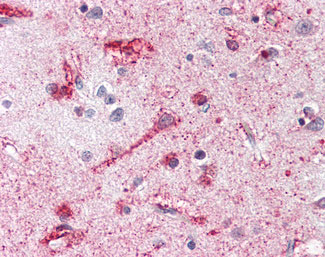MC4R / Melanocortin 4 Receptor Antibody (Cytoplasmic Domain)
Rabbit Polyclonal Antibody
- SPECIFICATION
- CITATIONS
- PROTOCOLS
- BACKGROUND

Application
| IHC-P |
|---|---|
| Primary Accession | P32245 |
| Reactivity | Human, Rabbit, Monkey, Sheep |
| Host | Rabbit |
| Clonality | Polyclonal |
| Calculated MW | 37kDa |
| Dilution | IHC-P (2.5-5 µg/ml) |
| Gene ID | 4160 |
|---|---|
| Other Names | Melanocortin receptor 4, MC4-R, MC4R |
| Target/Specificity | Human MC4 Receptor. BLAST analysis of the peptide immunogen showed no homology with other human proteins. |
| Reconstitution & Storage | Long term: -70°C; Short term: +4°C |
| Precautions | MC4R / Melanocortin 4 Receptor Antibody (Cytoplasmic Domain) is for research use only and not for use in diagnostic or therapeutic procedures. |
| Name | MC4R |
|---|---|
| Function | Hormone receptor that acts as a key component of the leptin- melanocortin pathway at the intersection of homeostatic maintenance of energetic state (PubMed:32327598, PubMed:33858992). Plays a role in regulating food intake: activation by a stimulating hormone such as anorexigenic alpha-melanocyte stimulating hormone (alpha-MSH) inhibits appetite, whereas binding to a natural antagonist like Agouti-related protein/AGRP promotes appetite. G-protein-coupled receptor that activates conventional Galphas signaling leading to induction of anorexogenic signaling in the hypothalamus to result in negative energy balance (PubMed:33858992). Regulates the firing activity of neurons from the hypothalamus by alpha-MSH and AGRP independently of Galphas signaling by ligand-induced coupling of closure of inwardly rectifying potassium channel KCNJ13 (By similarity). In intestinal epithelial cells, plays a role in the inhibition of hepatic glucose production via nesfatin-1/NUCB2 leading to increased cyclic adenosine monophosphate (cAMP) levels and glucagon-like peptide 1 (GLP-1) secretion in the intestinal epithelium (PubMed:39562740). |
| Cellular Location | Cell membrane; Multi-pass membrane protein |
| Tissue Location | Brain, placental, and gut tissues. |
| Volume | 50 µl |

Thousands of laboratories across the world have published research that depended on the performance of antibodies from Abcepta to advance their research. Check out links to articles that cite our products in major peer-reviewed journals, organized by research category.
info@abcepta.com, and receive a free "I Love Antibodies" mug.
Provided below are standard protocols that you may find useful for product applications.
Background
Receptor specific to the heptapeptide core common to adrenocorticotropic hormone and alpha-, beta-, and gamma-MSH. Plays a central role in energy homeostasis and somatic growth. This receptor is mediated by G proteins that stimulate adenylate cyclase (cAMP).
References
Gantz I.,et al.J. Biol. Chem. 268:15174-15179(1993).
Mountjoy K.G.,et al.Mol. Endocrinol. 8:1298-1308(1994).
Kopatz S.A.,et al.Submitted (JAN-2003) to the EMBL/GenBank/DDBJ databases.
Ota T.,et al.Nat. Genet. 36:40-45(2004).
Mural R.J.,et al.Submitted (JUL-2005) to the EMBL/GenBank/DDBJ databases.
If you have used an Abcepta product and would like to share how it has performed, please click on the "Submit Review" button and provide the requested information. Our staff will examine and post your review and contact you if needed.
If you have any additional inquiries please email technical services at tech@abcepta.com.













 Foundational characteristics of cancer include proliferation, angiogenesis, migration, evasion of apoptosis, and cellular immortality. Find key markers for these cellular processes and antibodies to detect them.
Foundational characteristics of cancer include proliferation, angiogenesis, migration, evasion of apoptosis, and cellular immortality. Find key markers for these cellular processes and antibodies to detect them. The SUMOplot™ Analysis Program predicts and scores sumoylation sites in your protein. SUMOylation is a post-translational modification involved in various cellular processes, such as nuclear-cytosolic transport, transcriptional regulation, apoptosis, protein stability, response to stress, and progression through the cell cycle.
The SUMOplot™ Analysis Program predicts and scores sumoylation sites in your protein. SUMOylation is a post-translational modification involved in various cellular processes, such as nuclear-cytosolic transport, transcriptional regulation, apoptosis, protein stability, response to stress, and progression through the cell cycle. The Autophagy Receptor Motif Plotter predicts and scores autophagy receptor binding sites in your protein. Identifying proteins connected to this pathway is critical to understanding the role of autophagy in physiological as well as pathological processes such as development, differentiation, neurodegenerative diseases, stress, infection, and cancer.
The Autophagy Receptor Motif Plotter predicts and scores autophagy receptor binding sites in your protein. Identifying proteins connected to this pathway is critical to understanding the role of autophagy in physiological as well as pathological processes such as development, differentiation, neurodegenerative diseases, stress, infection, and cancer.



